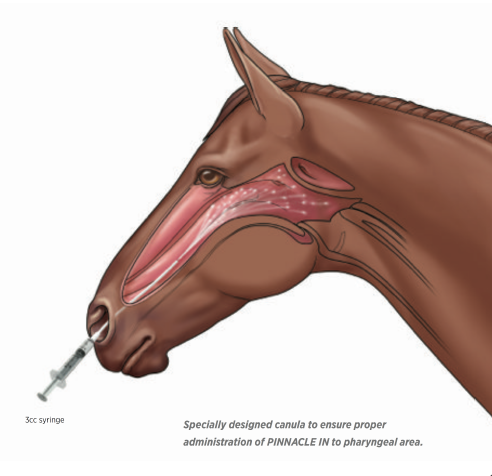Strangles is a highly contagious bacterial infection caused by Streptococcus equi subsp. equi. With the “classic form”, a horse will develop a high fever, nasal discharge, and abscesses of the lymph nodes in the throat region. The bacteria is easily spread from horse to horse, and requires labor intensive and time consuming strategies to fully eradicate from a barn. Alternate forms of the disease can also develop, including abscesses that form elsewhere in the body (bastard strangles), horses that persistently shed the bacteria long after clinical signs have subsided, and a life-threatening autoimmune reaction (purpura haemorrhagica). 
Can I vaccinate my horse for Strangles?
A vaccine for strangles does exist, but special consideration should be taken prior to administration, as its use is not without risks.
The greatest risk with the use of the strangles vaccine is the development of purpura haemorrhagica, the same life-threatening autoimmune reaction that can occur from true strangles infection. Normally, when a horse is exposed to the live bacteria or vaccine, the immune system develops antibodies so it can recognize the bacteria in the future. When a horse with a particularly high level of antibodies is exposed to the live bacteria or vaccine, the horse’s immune system can have too strong a response, causing it to malfunction and attack itself (aka, an autoimmune reaction). Clinical signs of purpura haemorrhagica include severe swelling of the body due to vasculitis (inflammation of the blood vessels), fever, destruction of necessary blood cells, and coagulopathies (reduced ability to form blood clots).
The vaccination is administered intra-nasally and is classified as “modified live”. This means that the bacteria within the vaccine is weakened, but not completely killed. If any of the vaccine particles are inadvertently injected, it can lead to large injection site reactions and abscesses. This can be caused by something as simple as particles that your horse breathes out landing on the haircoat in the same area where an injection is given. To prevent such a complication, we recommend strangles vaccines be administered during the end of the appointment, after all other injections have been given, and we do not give this vaccine at the same time as having a dental float. Alternatively, and arguably the safest method, strangles vaccines can be administered at a separate appointment from all other vaccinations and injections.
How do I know if it is safe to vaccinate my horse?
Horses with extremely high antibody levels were usually exposed to the strangles bacteria at some point in their life. It’s a myth that a horse who has had strangles in the past can never get it again, but it can lead to them maintaining a strong immune response for a long time after infection. It’s impossible to identify horses with high antibody levels just by looking at them, but luckily there is a simple blood test to measure their levels, known as an “S. equi M-protein (SeM) titer.” For this test, a small sample of blood is drawn and sent to a lab, and your horse’s results are available in about a week.
How frequently does my horse need to be vaccinated?
The strangles vaccine is administered yearly. If this is the first time your horse is receiving the strangles vaccine, they will need an initial dose followed by a booster 2-3 weeks later.
What other ways can I protect my horse?
Good biosecurity practices are equally as important in the fight to protect your horse from contagious diseases. See Facts about Strangles & Biosecurity to Prevent Strangles from the Indiana Board of Animal Health
Other good sources of information:
- Zoetis Animal Health Strangles Technical Bulletin
- The Horse Magazine Strangles: Dispelling the Myths by Christy Corp-Minamiji, DVM – Nov 24, 2014 Go here if the link is broken.
- ACVIM Concensus Statement: Strep Equi